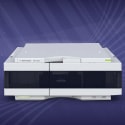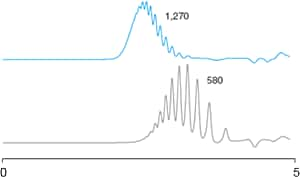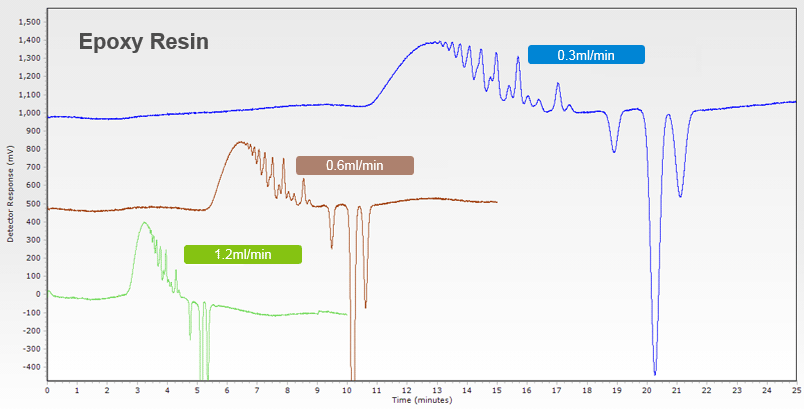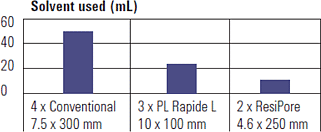Access Agilent eNewsletter March 2016

Agilent 1290 Infinity II RID delivers high resolution and rapid polymer characterization
Graham Cleaver, Agilent Business Development Manager for ELSD/GPC/RID
With increased pressure for higher throughputs and lower costs, gel permeation chromatography (GPC) professionals are demanding greater speed, better resolution, and reduced expenses in their lab operations.
To address these challenges, Agilent has added a new micro flow cell refractive index detector to the 1290 Infinity II platform. Recently launched on January 1st 2016, the detector and Agilent Infinity II system have been optimized to deliver high-resolution polymer separations in less than five minutes. Not only does it offer a 70% reduction in run time, but also a 50% reduction in solvent consumption, greatly reducing cost of sample analysis.
All of the performance features and benefits associated with the Agilent 1290 Infinity II system, coupled with highly linear range mixed pore columns, deliver accurate molecular weights and distribution profiles which are in excellent alignment with results obtained in both micro and analytical mode. Let’s examine the proof behind these capabilities.
Micro detection means higher resolution
The Agilent 1290 Infinity II system with an Agilent 1290 Infinity II Refractive Index Detector provides excellent baseline stability, which is crucial in obtaining accurate and reproducible molecular weights. GPC is almost always an isocratic separation mechanism, but the versatility of the 1290 Infinity platform also offers the ability to run HPLC applications, micro GPC, and analytical GPC all on the same system.
Utilization of low system dead volume coupled with the 2.5 µL RI flow cell is what delivers the higher performance when compared to analytical GPC.
Figure 1 shows two relatively low molecular weight polystyrene standards. It has been demonstrated that a certain degree of oligomeric separation can be achieved by conventional GPC. Oligomers up to and including pentamers can be identified from the molecular weight distribution profile.
Boost sample throughputs with micro detection technology
Reducing analysis time is beneficial for numerous reasons, as more samples can be chromatographed and processed (Figure 2). Solvent costs can be dramatically reduced, but not at the expense of accuracy and reproducibility.
In analytical mode, it can take up to 30 minutes to achieve resolution with 300 x 7.5 mm columns. Micro detection GPC reduces the run time to less than five minutes.
Accurate, reproducible molecular weight distributions with mixed pore particle technology
The use of individual pore size columns in GPC is often problematic because spurious peak shapes can be created and precision lost in the calculated molecular weight averages due to “mismatched” calibration curves. Agilent PlusPore columns overcome this issue through the use of mixed pore particle technology to eliminate issues with peak fronting, tailing, and dislocations (Shown in Figure 3).
Note the narrow distribution polystyrene was chromatographed on three different column sets to prove that the results obtained in “micro mode” were consistent with those in analytical mode.
In this example, the 4 x PLgel columns are standard analytical 300 x 7.5 mm mixed bed columns, hence the longer retention time. Moving down to micro mode, the retention time (Tr) reduces, whereas peak asymmetry (a) and the peak resolution (Rs) are retained within acceptable experimental error (Table 1).
| Columns | Tr (Peak 2) | Rs | N/m (Peak 2) | a | Area (%) | Height (%) |
|---|---|---|---|---|---|---|
| 4 x PLgel | 28.46 | 1.22 | 5653 | 1.05 | 8 | 7 |
| 3 x PL Rapide L | 7.41 | 1.13 | 23727 | 1.06 | 7 | 7 |
| 2 x ResiPore | 6.66 | 1.10 | 14510 | 1.05 | 8 | 8 |
Table 1. Standard and micro mode chromatographic analysis results.
Table 2 shows the molecular weights obtained from a sample containing two polymer standards which are baseline resolved. Since all of the column sets in this trial use PS/DVB resins with linear calibration curve, the results achieved from conventional analytical scale have extremely good agreement from those produced using mixed pore columns with the micro scale refractive index detector. Analytical scale methods are directly transferrable to micro scale to achieve faster run times, while preserving accuracy in molecular weight determination.
| Mp | Mn | Mw | PD | Mp | Mn | Mw | PD | |
|---|---|---|---|---|---|---|---|---|
| Peak 1 | Peak 2 | |||||||
| Mean | 110262 | 107964 | 111181 | 1.03 | 56041 | 51015 | 53208 | 1.05 |
| %RSD | 3 | 1 | 1 | 0 | 5 | 8 | 5 | 4 |
Table 2. Molecular weights obtained from a sample containing two polymer standards and column sets using PS/DVB resins with linear calibration curve.
Considerable cost savings achieved with microanalysis
In transferring from analytical to microanalysis mode, considerable cost savings are realized on top of the environmental benefits from reducing the volume of solvent required. Table 3 illustrates how a 70% saving in analysis time also reduces solvent consumption by 55%. Even further savings are achieved by moving to narrower bore columns.
Micro GPC delivers shorter run times, enhanced reproducibility, and higher accuracy
The Agilent 1290 Infinity II Refractive Index Detector offers a reduced cell volume, extremely low dispersion tubing, multipore column technology and software all from a single vendor. Applications, service, and support maximize system uptime and the micro configuration provides accurate, reproducible results. Additionally, shorter run times enable high sample throughput without deterioration in reproducibility or accuracy of results. The Agilent 1290 Infinity II system also features ultra low system dispersion, ensuring that resolution is maintained, run times are reduced, and costs are considerably lowered. What’s more, micro, analytical scale, and isocratic HPLC are all possible on the same system.
Agilent offers a wide array of LC, HPLC, and GPC solutions
Agilent offers the most comprehensive portfolio of high quality solutions for gel permeation chromatography, liquid chromatography, and high performance liquid chromatography. No matter what type of polymer analysis you are working on, Agilent has market-leading instrumentation, columns, standards and data analysis software to match any application and budget. Contact your Agilent Representative today and find out how these solutions can improve operations in your lab.
Stay informed about the applications that are important to you
Subscribe to Access Agilent
Our free customized
monthly eNewsletter
Article Directory – March 2016
All articles in this issue
 Evolution of multiple heart-cutting 2D-LC: Agilent 1290 Infinity II provides high-resolution sampling and easy quantitation
Evolution of multiple heart-cutting 2D-LC: Agilent 1290 Infinity II provides high-resolution sampling and easy quantitation Tip: How to achieve efficient, effortless LC method transfer to the Agilent 1290 Infinity II LC System
Tip: How to achieve efficient, effortless LC method transfer to the Agilent 1290 Infinity II LC System Agilent 1290 Infinity II RID delivers high resolution and rapid polymer characterization
Agilent 1290 Infinity II RID delivers high resolution and rapid polymer characterization Dual-needle option for LC autosamplers provides improved speed, flexibility, and accuracy
Dual-needle option for LC autosamplers provides improved speed, flexibility, and accuracy Multiple heart-cutting 2D-LC/MS method for reproducible resolution of chiral drug metabolites
Multiple heart-cutting 2D-LC/MS method for reproducible resolution of chiral drug metabolites Quick, accurate screening for suspect environmental contaminants with Agilent solutions
Quick, accurate screening for suspect environmental contaminants with Agilent solutions
Figure 1

Rapid high resolution run times.
Figure 2

Agilent 1290 Infinity II micro GPC solution achieves resolution in under five minutes.
Figure 3

Reduced dislocations, peak fronting, and tailing with the use of mixed pore technology.
Table 3

Less solvent used with micro analysis mode of gel permeation chromatography.